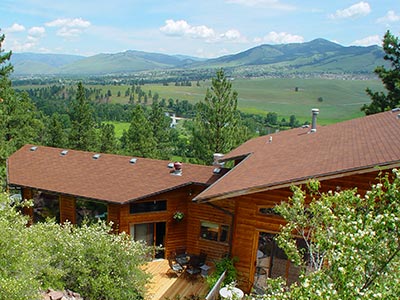The scenic Blue Mountain Nature Trail makes the perfect introduction to hiking in the Lolo National Forest. The Missoula Valley comes to life in the spring and nature lovers flock to the miles of hiking trails. Those new to the area get a wonderful overview and history on the nature trail. Even though it’s only a quarter mile long the marked points of interest and corresponding brochure are full of fascinating facts. The trail invites hikers to take their time while learning about the trees, plants, birds and other animals along the way. The story of the 2003 wildfire unfolds with each step on the trail that includes a panoramic vista at the midway point. Here visitors can compare the new landscape to a 100 year-old photograph of the same view.
The Blue Mountain Bed and Breakfast also offers guests sweeping vistas from our mountainside location. Relax on the multi-level decks and take in amazing views of the valley, Bitterroot River and distant mountains. While a tranquil retreat, we’re close to all the outdoor recreation and Missoula’s lively downtown. It’s time to book your hiking retreat and explore Missoula’s stunning landscape this spring and summer.
The Blue Mountain Nature Trail – a Wildfire History
The Missoula area is a hiker’s dream with miles of trails in forests, along rivers and to summit vistas. The Blue Mountain Nature Trail certainly delivers on views and scenery, but it’s more a living history museum. Those walking the nature trail will journey through the transformative story of the landscape that begins with the 2003 wildfire.
When lightning struck the Black Mountain a wildfire was set off, burning 7,000 acres. Years after the destruction of forests and plants, the area has recovered and changed. The Nature trail guides hikers through the transformed terrain. Forests of charred trees now house woodpeckers. This results in a variety of woodpeckers including black-backed, three-toed, pileated, hairy and downy. The fire-cleared meadows also attracts many songbirds such as mountain bluebirds, western tanager, and western wood-pewee.
The once shady forest floor is now covered in a sea of tall grasses, wildflowers, mosses and mushrooms. During spring and early summer the hillsides explode with color from arnica, fireweed, glacier lily and arrowleaf balsamroot. These wildflowers paint the landscape with brilliant fuchsia, pinks and yellows. While thick mosses and even the prized morel mushrooms carpet the ground. Not surprisingly, the delicious morsels are a favorite snack for the local deer and chipmunks.
Along the trail many large trees remain, their thick bark protected them during the blaze. Fallen ponderosa pines continued to grow into dramatic twisted shapes. While other trees bare scars that map fires over the centuries. At the trail’s midpoint, step out of the sheltering trees and enjoy a wonderful vista of the Missoula Valley, the Bitterroot River and distant mountains. The brochure provides a hundred year old photo of the same view to compare. It’s a clear illustration of how dramatically the landscape has changed.
If you’re up for more hiking connect to the nearby Blue Mountain National Recreation Trail or return another day to explore. The Blue Mountain Bed and Breakfast, close to miles of excellent hiking trails, is a relaxing secluded retreat. Return to your private guest suite and soothe tired muscles in your own jetted tub. Our hearty gourmet breakfast will also have you ready for another day on the trails. Reserve your room with is today and plan your escape to our piece of paradise.





